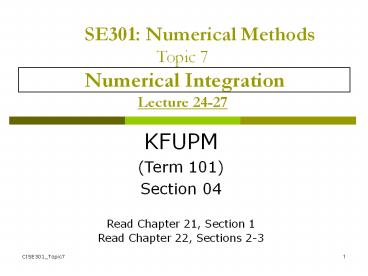SE301: Numerical Methods Topic 7 Numerical Integration Lecture 24-27 PowerPoint PPT Presentation
Title: SE301: Numerical Methods Topic 7 Numerical Integration Lecture 24-27
1
SE301 Numerical MethodsTopic 7
Numerical Integration Lecture 24-27
KFUPM (Term 101) Section 04 Read Chapter 21,
Section 1 Read Chapter 22, Sections 2-3
2
Lecture 24Introduction to Numerical Integration
- Definitions
- Upper and Lower Sums
- Trapezoid Method (Newton-Cotes Methods)
- Romberg Method
- Gauss Quadrature
- Examples
3
Integration
Indefinite Integrals Indefinite Integrals of a
function are functions that differ from each
other by a constant.
Definite Integrals Definite Integrals are
numbers.
4
Fundamental Theorem of Calculus
5
The Area Under the Curve
One interpretation of the definite integral is
Integral area under the curve
f(x)
a
b
6
Upper and Lower Sums
The interval is divided into subintervals.
f(x)
a
b
7
Upper and Lower Sums
f(x)
a
b
8
Example
9
Example
10
Upper and Lower Sums
- Estimates based on Upper and Lower Sums are easy
to obtain for monotonic functions (always
increasing or always decreasing). - For non-monotonic functions, finding maximum and
minimum of the function can be difficult and
other methods can be more attractive.
11
Newton-Cotes Methods
- In Newton-Cote Methods, the function is
approximated by a polynomial of order n. - Computing the integral of a polynomial is easy.
12
Newton-Cotes Methods
- Trapezoid Method (First Order Polynomials are
used) - Simpson 1/3 Rule (Second Order Polynomials are
used)
13
Lecture 25Trapezoid Method
- Derivation-One Interval
- Multiple Application Rule
- Estimating the Error
- Recursive Trapezoid Method
- Read 21.1
14
Trapezoid Method
f(x)
15
Trapezoid MethodDerivation-One Interval
16
Trapezoid Method
f(x)
17
Trapezoid MethodMultiple Application Rule
f(x)
x
a
b
18
Trapezoid MethodGeneral Formula and Special Case
19
Example
Given a tabulated values of the velocity of an
object. Obtain an estimate of the distance
traveled in the interval 0,3.
Time (s) 0.0 1.0 2.0 3.0
Velocity (m/s) 0.0 10 12 14
Distance integral of the velocity
20
Example 1
Time (s) 0.0 1.0 2.0 3.0
Velocity (m/s) 0.0 10 12 14
21
Error in estimating the integralTheorem
22
Estimating the Error For Trapezoid Method
23
Example
24
Example
x 1.0 1.5 2.0 2.5 3.0
f(x) 2.1 3.2 3.4 2.8 2.7
25
Example
x 1.0 1.5 2.0 2.5 3.0
f(x) 2.1 3.2 3.4 2.8 2.7
26
Recursive Trapezoid Method
f(x)
27
Recursive Trapezoid Method
f(x)
Based on previous estimate
Based on new point
28
Recursive Trapezoid Method
f(x)
Based on previous estimate
Based on new points
29
Recursive Trapezoid MethodFormulas
30
Recursive Trapezoid Method
31
Example on Recursive Trapezoid
n h R(n,0)
0 (b-a)?/2 (?/4)sin(0) sin(?/2)0.785398
1 (b-a)/2?/4 R(0,0)/2 (?/4) sin(?/4) 0.948059
2 (b-a)/4?/8 R(1,0)/2 (?/8)sin(?/8)sin(3?/8) 0.987116
3 (b-a)/8?/16 R(2,0)/2 (?/16)sin(?/16)sin(3?/16)sin(5?/16) sin(7?/16) 0.996785
Estimated Error R(3,0) R(2,0) 0.009669
32
Advantages of Recursive Trapezoid
- Recursive Trapezoid
- Gives the same answer as the standard Trapezoid
method. - Makes use of the available information to reduce
the computation time. - Useful if the number of iterations is not known
in advance.
33
Lecture 26Romberg Method
- Motivation
- Derivation of Romberg Method
- Romberg Method
- Example
- When to stop?
- Read 22.2
34
Motivation for Romberg Method
- Trapezoid formula with a sub-interval h gives an
error of the order O(h2). - We can combine two Trapezoid estimates with
intervals h and h/2 to get a better estimate.
35
Romberg Method
R(0,0)
R(1,0) R(1,1)
R(2,0) R(2,1) R(2,2)
R(3,0) R(3,1) R(3,2) R(3,3)
First column is obtained using Trapezoid Method
The other elements are obtained using the
Romberg Method
36
First Column Recursive Trapezoid Method
37
Derivation of Romberg Method
38
Romberg Method
R(0,0)
R(1,0) R(1,1)
R(2,0) R(2,1) R(2,2)
R(3,0) R(3,1) R(3,2) R(3,3)
39
Property of Romberg Method
R(0,0)
R(1,0) R(1,1)
R(2,0) R(2,1) R(2,2)
R(3,0) R(3,1) R(3,2) R(3,3)
Error Level
40
Example
0.5
3/8 1/3
41
Example (cont.)
0.5
3/8 1/3
11/32 1/3 1/3
42
When do we stop?
43
Lecture 27Gauss Quadrature
- Motivation
- General integration formula
- Read 22.3
44
Motivation
45
General Integration Formula
46
Lagrange Interpolation
47
Example
- Determine the Gauss Quadrature Formula of
- If the nodes are given as (-1, 0 , 1)
- Solution First we need to find l0(x), l1(x),
l2(x) - Then compute
48
Solution
49
Using the Gauss Quadrature Formula
50
Using the Gauss Quadrature Formula
51
Improper Integrals

